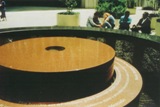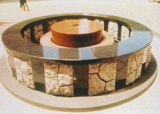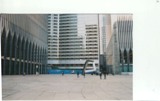This article may not be published or printed elsewhere without the express permission of IFAR
September 11th:
ART LOSS, DAMAGE, AND REPERCUSSIONS
Proceedings of an IFAR Symposium on February 28, 2002
The World Trade Center Memorial, 1993
by Elyn Zimmerman
[Elyn Zimmerman is the sculptor of the World Trade Center Memorial,1993,
commissioned by the Port Authority of New York and New Jersey.]
Working on the World Trade Center memorial project in 1994-95 (Fig. 1) was a very different experience from anything else I've done. Artists make small works in their studios, and if they have the interest, they can be commissioned to do large projects for public spaces. What you bring to those projects is very different from what you bring to an experience like the memorial for the 1993 bombing, It is not a typical project to make a memorial.
In 1993, a terrorist car bomb went off below a site between Towers One and Two of the World Trade Center, several levels down in the parking area. Six people were killed, and more than 1,000 were injured. I was one of a number of artists later invited to submit proposals for a memorial to be placed above the exact spot where the bomb exploded, The specific site chosen was 30 feet by 30 feet (Fig. 2). We had a chance to meet with the families who had lost their loved ones. The memorial that I proposed was accepted and constructed.
I'd like to take you through the creative process and my reasoning as to how this fountain came into being. The plaza was really large, and, unfortunately, the amount of money for the memorial was not up to the size of the plaza. Moreover, there were already so many large sculptures on the plaza itself, and trees, and those huge buildings, that it was ridiculous to think of competing with that.
The underlying idea was that there would be an inscription of some sort. I decided to try to make a form that might bring people closer to it. In order to read the inscription, they'd have to walk up to it and look inside (Fig. 3).
 Figure 3. Overhead view of the Memorial showing the inscription and the names of the six people killed in the 1993 WTC car bombing. Photo: E. Zimmerman |
Essentially, the footprint of the memorial was a thirty foot square trimmed in black granite. The interior paving was white granite, and then there was a form that was about 18 feet in diameter and 3 1/2 feet high. The fountain itself was very modest. It was not a huge flowing thing of water, but from the center of the red disk, there was a small hole, from which water came out and flowed evenly over the sides of the disk and into a slot. Around the red disk was a brief inscription and the names of the six people that were killed in 1993. So, one would walk up to it and look into the center and see the inscription. Also, there was a pool of water that these elements sat in on the interior. The inscription read:
On February 26, 1993, a bomb set by terrorists exploded
below this site. This horrible act of violence killed innocent
people, injured thousands, and made victims of us all.
And then there were the names. Many of the victims were Hispanic or of Hispanic origin, so the inscription was in both Spanish and English.
Later trees and shrubbery were brought and placed around two sides. Also, people began throwing coins inside the fountain. I had no idea that was going to happen, so we had to shut off the water and install a filter to catch the coins. I think it meant something to the people who worked in the building and knew the people who were killed, and also to the visitors. There were so many visitors to the World Trade Center.
How did I come to design something like this? In 1980, I started doing outdoor sculpture commissions. I was very inspired by geology, and things in nature, and Japanese and Chinese gardens. I became interested in using rocks and water, and I had the very good fortune to do a project at the National Geographic Society in Washington with those materials. It was a huge learning experience. A few years later, I got interested in archaic architecture, the very beginnings of architecture, and thought a lot about ancient temples and sites that incorporated natural rocks and had man-made platforms built around them. I visited the site in Greece of the oracle of Delphi, and that stayed in the back of my mind. I take a lot of pictures and keep a lot of reference files. When the cancer center at the University of South Florida had a competition for an outdoor sculpture next to their new building, I thought of the site as a sanctuary and a place for long-term hospital residents to come outside and sit. So, the form of my sculpture referred back to the plan of the sanctuary at Delphi, but reinterpreted. It includes a fountain and a small pool and a place for people to sit, which is important. It is a very quiet place.
A plaza I designed in San Francisco off Market Street also refers back to archaic architecture. I had recently visited the Incan ruins in Peru and was taken with the large stonework and articulated blocks they had used. For my San Francisco project, two waterwalls face each other in a garden just off Market Street in front of an office tower.
These projects were all done before 1993, and there were many others as well. They show that I already had this vocabulary of stone and water. Stone has cultural references as monuments and tumulus mounds. I didn't feel intimidated by that; rather, I felt it adds dignity to a work. So, when I started thinking about the World Trade Center memorial competition, I went back to some of the books I had looked at and thought of these tumulus mounds and how from time immemorial, people captured the experience of passage, entombing people who were important in their culture. They would do it in these mound-like structures. Very early on you had things like Stonehenge and those kinds of mound structures. But around the first millennium BC, you get not just mounds of earth but actual constructions of cut stone mixed in with rubble and earth. I was inspired by these. I was also attracted to their minimalist form. I came out of a period in the art world when there was a strong influence of Minimalism. I found these forms very powerful, very engaging. They're iconic. That's what I began to think about, and I developed the World Trade Center form. It has a combination of very rough white granite that's broken into large chunks forming the walls, and it's topped and finished and held in place by polished granite pieces.
I saw what happened on September 11th; I was there. I live half a mile from the site, and my studio is there too. We saw the planes go over and the buildings collapse. One of the first things that came to my mind was that this memorial had been an art project for me. It meant a lot, but for me, it wasn't a shrine the way it was to the families who had lost loved ones in 1993. The press recently has been saying the same thing—that those families had a double loss: they lost their family members and now they lost the memorial to them. What occurs to me is that you can build a lot of stone memorials, and if people are determined, they'll be destroyed along with everything else.
Finis
To read transcripts of the other talks, please click on the desired topic below.
| Public Art at the World Trade Center -Saul S. Wenegrat | Response from the Insurance Industry -Dietrich von Frank |
| The World Trade Center Memorial, 1993 -Elyn Zimmerman | The Insurance Adjuster's Role -Gregory J. Smith |
| The Artist Residency Program in the Twin Towers -Moukhtar Kocache |
The Downtown Institutional Impact -John Haworth |
| The Art Lost by Citigroup on 9/11 -Suzanne F.W. Lemakis |
The Heritage Emergency National Task Force - Lawrence L. Reger |

